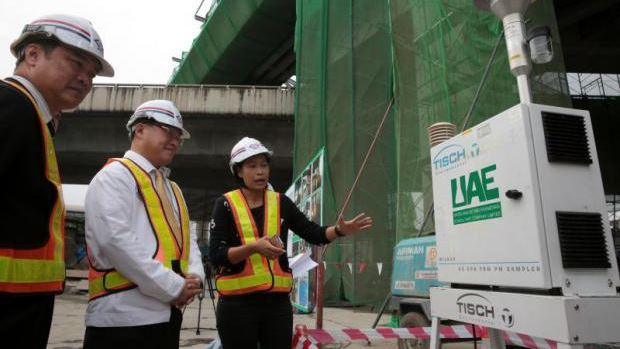Chayapol Thitisak, Director-General of the Department of Disaster Prevention and Mitigation, said unsafe concentrations of PM2.5 particles were detected in tambon Song Khanong in Phra Pradaeng district of Samut Prakan, Tambon Omnoi of Krathum Baen district and Rama II Rd in Muang District of Samut Sakhon, and Tambon Nakhon Pathom of Muang District in Nakhon Pathom.
In these areas, PM2.5 levels were measured at 54-74 microgrammes per cubic metre (µg/m³), exceeding the “safe” level of 50 µg/m³.
Officials have been deployed to spray water and clamp down on the open burning of farm waste and rubbish in the affected districts.
Open burning is one source of PM2.5 – fine dust particles with a diameter 1/20 the width of a human hair.
Others are emissions from power plants burning fossil fuels and emissions from cars which run on low-grade fuel with a high sulphur content.
PM2.5 is a health hazard as it has been proven to cause damage to the human respiratory system as well as exacerbate a number of other conditions such as cardiovascular disease.
In response to the crisis, academics have urged the government to create more green areas in the city as well as promote public transport and curb open burning.
“To deal with this problem in the long run, the city needs more green areas, as trees and plants can help clean the air… Many green zones in Bangkok are disappearing and being turned into locations for new buildings,” Assoc Prof Sura Phatthanakiat from the Faculty of Environment and Resource Studies at Mahidol University said yesterday in a seminar on the issue organised by Siriraj Hospital.
Jackrit Suthakorn, dean of Mahidol University’s engineering faculty said in the same seminar that the government needs to remain vigilant because open burning in Bangkok and the surrounding areas usually peaks between January and March.
The Department of Health, meanwhile, expressed concern over the long-term impact of the dust particles on children living in affected areas, saying their exposure may lead to several health problems in the long-term, including coronary artery disease.
The department has advised parents to monitor air quality using the mobile app Air4Thai or website www.anamai.moph.go.th
Wind brought some relief yesterday as PM2.5 levels dropped in greater Bangkok, but pollution lingered in some areas including along the capital's Rama IV Rd.
Read original story here.








